Win More Guests with a Great 1st Impression [Webinar]

As occupancy starts to ramp back up across the country, hoteliers are looking for every opportunity to gain a strategic advantage over local competitors. One of the biggest factors that will determine your hotel’s ability to capture more guests during this time is your hotel’s first impression online. With Travel Media Group’s 1st Impression Score™ hoteliers can see in real-time how competitive their hotel is across all online booking sites. Let’s explore what factors influence a hotel’s 1st Impression Score™ and how to improve that score in order to capture and win more guests.
The 4 Factors of TMG’s 1st Impression Score™
1st Impression Score™ is a first of its kind, reputation metric that is designed to evaluate your hotel’s reputation in real-time and show you how it impacts booking decisions right then and now. The score is compiled by using 4 different reputation factors:
- Lifetime Score – which is the average score of all the reviews your hotel has ever received.
- Review Flow – which is based on how frequently new reviews about your hotel are posted.
- Recent Reviews – which measures the average review score on the first page of your review sites.
- Review Response Rate – which indicates how many of your reviews have responses.
While most old fashioned reputation reports and tools show you only some of these factors individually. 1st Impression Score™ factors all of them into one combined metric. So let’s take a look at each one of these factors and demonstrate why it was important to include within the 1st Impression Score™ and how it plays into today’s post-COVID-19 world.
Lifetime Score
The first factor we will look at is Lifetime Score. The original reputation metric. For years this score was the focus and starting point for travelers as they began their online booking journey. As time has passed and the number of online reviews continues to grow, this score has become more and more difficult for hoteliers to impact in the short term.
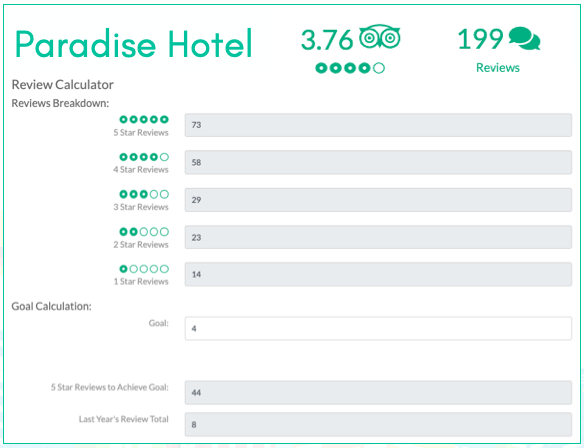
Let’s look at the Hotel Paradise as an example. This is a TripAdvisor performance report created by Travel Media Group; it showcases how many reviews are needed in order to impact and improve a hotel’s lifetime score. In this example, we see this property currently sits at a 3.76 lifetime score with almost 200 reviews on TripAdvisor. Their goal is to be at a 4.0 lifetime score by the end of 2020, so improve their score by .24. You might see this and think of it as a modest goal – with a whole year to work with they should achieve this in no time. Yet, when we dig into the details, using this report we see that this goal is actually very ambitious and without a reputation strategy could be unachievable. So when we run this report we see that in order to move that lifetime score to a 4.0 and achieve their goal they will need to generate 44 5-star reviews. Not 4-star or 3-star reviews, 44 5-star reviews. That’s also assuming that the hotel needs no additional 5-star reviews to offset any negative reviews received during that time.
You may be thinking 44 is not too bad, the hotel already has 73 lifetime 5-star reviews as it is. What’s another 44? Here is the problem, the Hotel Paradise only received 8 reviews total last year. Now let’s assume that the Hotel Paradise got lucky and all 8 of those reviews were 5-star reviews. If they continued with that pace of generating only 8 5-star reviews per year. It would take them 5 and a half years to achieve their goal of a 4.0 lifetime score.
That’s why in 2020 it is so critical for hotels to implement a reputation strategy to speed up the amount of time required to impact and improve lifetime score. Most of these reputation strategies including ours at Travel Media Group have to do with speeding up the next factor in our 1st Impression Score™, review flow.
Review Flow
Review flow is a byproduct of lifetime score and is a metric that brands and other reputation reports have really zeroed in on recently. Some of your brand specific reputation reports might showcase your hotel’s reviews in different buckets, like last 90, 60, and 30 days. But how useful are these numbers and reports when review flow unexpectedly stops?
Since March, at the start of COVID-19 pandemic, your hotel’s review flow might have dropped from the high double digits to less than 5 in the past 60 to 90 days. So what takeaways can a hotelier get from a reputation report that shows such little data? How do you determine how competitive your hotel is in comparison to others in the market?
The problem is when you use reputation reporting like this and illustrate review flow this way, it gives the impression that no reviews equals nothing there. Hoteliers were reading these reputation reports, seeing zeros in their 7 day or 30 day review flow buckets and assuming that travelers weren’t using reviews to make their booking decisions.
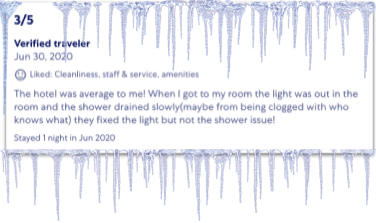
But online reviews didn’t disappear, they froze. The reviews your hotel received prior to the pandemic were the first reviews travelers were seeing when they started researching where to stay when stay at home orders were lifted and depending on what those last reviews looked like, impacted how quickly you started to see an increase in occupancy. However, those brand reputation reports didn’t show that, they showed zeros, with little data and little context for hoteliers. With 1st Impression Score™, our hotel partners could see how they stacked up against their competition throughout the entirety of the pandemic, which helped better prepare them for occupancy recovery by leveraging their hotel’s online reputation.
Recent Reviews

The next factor calculated in Travel Media Group’s 1st Impression Score™ is recent reviews. This reputation metric has also been greatly affected by COVID-19. Prior to the pandemic, consumers were traveling at an all-time high and were leaving a record number of reviews online. These reviews had a wide range of sentiment and emotion, scattering the reputation rating spectrum from a terrible, 1-star review, all the way to a perfect, 5-star review, and everything in between.

Today, we’ve noticed traveler’s online reviews to be way more polarizing. People traveling right now feel a responsibility and obligation to let others know if they felt safe or unsafe during their stay, but they also realize how hard the travel industry is hurting right now and want to do everything in their power to support it and your business. What this causes, is for your hotel’s recent reviews to most likely fall on either one of the extreme sides of the rating spectrum.
That guest that might have given you a pass 6 months ago, if they noticed that their room wasn’t as clean as expected, is not giving you the benefit of the doubt anymore. What may have been a 2- or 3-star rating will most surely be a 1-star and feature devastating keywords like “unclean” or “not sanitary”, which will absolutely have lasting impacts on your business. The guest that might have been a little knit picky about the little details of their stay and left you a neutral or 4-star rating, today might be willing to overlook those minor mishaps and help your business by leaving you a raving, 5-star review. And with review flow decreasing, this is making your hotel’s recent reviews exponentially more impactful, increasing your need for a reputation tool and strategy to help you generate and manage these recent reviews.
Once you received a review online, it’s time for the fourth and final piece factored in your hotel’s 1st Impression Score™, review response rate.
Review Response Rate
So why include review response rate into our 1st Impression Score™ formula? Can something like responding to a review truly have an impact on a traveler’s booking decision? Well, let’s take a look at an example in today’s post-COVID-19 world where that is just the case.
Below is a terrible 1-star review posted recently, titled “Very Disappointed” :
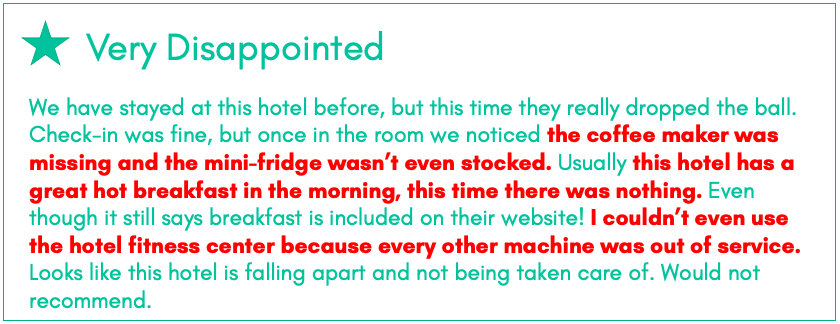
So clearly the expectations of this guest were not met. It was a completely different type of experience than they had encountered in the past and felt that the hotel really missed the mark. Without a review response, future traveler’s first impression of this property is not good and most likely costing the hotel business every minute that it remains in the public eye and unresponded.
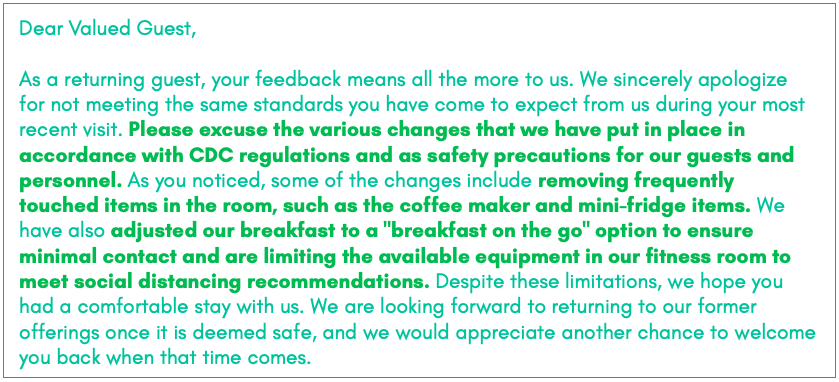
By leveraging the power of review response, the property was actually able to tell their side of the story and justify why expectations were not met. You see the truth is that all of the issues raised by the travelers were actually operational changes implemented at the property due to COVID-19. New protocols like removing frequently touched items in the room, launching a grab and go breakfast at the property, and new policy updates to promote social distancing in their amenity areas. Without a review response, travelers with future stays would never know this.
How many more negative reviews would this hotel have received if they didn’t properly communicate these changes over review response? Travelers are paying more attention than ever before and this is why professional and timely review response is critical to a hotel’s overall reputation and why we included it as a major factor in a hotel 1st Impression Score™.
Capturing More Guests with TMG’s 1st Impression Score™
So you see, especially today in a post-COVID-19 world, how all 4 of these factors play major roles in how your travelers are viewing and judging your hotel right now, at this very moment. It’s a score that is fluid, changing in real-time as you receive more reviews and respond to them. This is an example of what Travel Media Group’s first impression score looks like. It scores your hotel on each one of the 4 factors and on each individual site, giving you an indicator of where to focus your team’s energy and attention to make sure you are capturing the most revenue. Our hotel partners are utilizing this score on a daily basis to speed their recovery by ensuring they are outperforming competitors in their market and giving off the best first impression no matter where they are being found by travelers online.



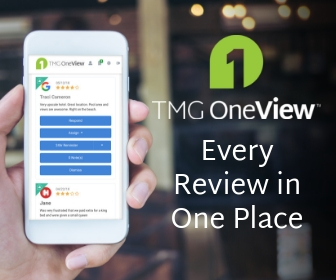
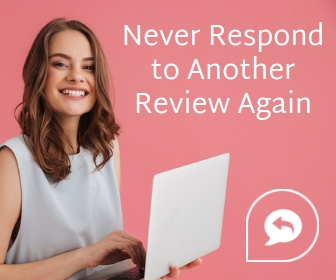
0 Comments